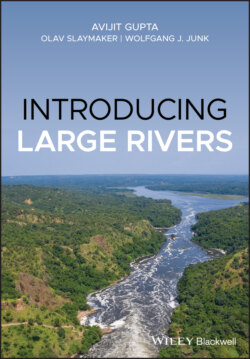Читать книгу Introducing Large Rivers - Avijit Gupta - Страница 41
4.4.4 Morphology
ОглавлениеIn the Himalaya Mountains, Ganga and its headwater tributaries flow in narrow, gorge-like valleys flanked by small discontinuous patches of floodplains and terraces. After emerging from the mountains, in the wide alluvial plain between the Himalaya and the cratonic Peninsular India, the rivers are entrenched below the surface of the plain. The channel of the Ganga is confined within a 10–25 km wide elongated lowland, bounded by alluvial cliffs, several metres high. The cliffs are eroded by gullies and small ravines. The lowland bounded by the cliffs comprise: (i) the channel of the Ganga commonly displaying braid bars and meander scars, (ii) the floodplain, (iii) terrace-like features which are higher than the floodplain, and (iv) miscellaneous wetlands. The river channel and the floodplain together extend up to 3 km in width. Large sand bars, kilometres in length, are common in the channel. The Ganga remains confined within this cliff-bounded valley and rarely overtops the cliffs, even in large floods. The floodplain and terrace-like features, however, are inundated periodically, the frequency depending on their height above the channel. The channel pattern of the Ganga changes from place to place (Figure 4.8), and the wide valley between alluvial cliffs is modified by various agencies: the main channel of the Ganga; the smaller channels; the miscellaneous water bodies on the floodplain; and the alteration of the cliff slopes.
Being a seasonal river, the channel of the Ganga is full of bars and multiple channels in the dry season. Huge kilometre-scale bars consisting of braid bars, lateral bars, and point bars are visible at low flow. The low flow effect is enhanced by the large-scale transfer of water into irrigation canals or to meet other demands. In places, the river displays a meandering pattern with point bars and local narrowing of the channel due to extensions of peninsular lineaments under alluvium. The river may briefly change its direction in such locations. The meandering pattern using the entire channel commonly appears in high flows when nearly the entire channel is under water and mid-channel bars are submerged and removed. During the dry season, however, a braided pattern may re-emerge between the cliffs, as has been described for the Narmada (Gupta et al. 1999), for rivers of monsoon areas.
Figure 4.8 The Ganga from satellite imagery in alluvium, bars and bends.
Source: NASA Worldview application (https://worldview.earthdata.nasa.gov), part of the NASA EOSDIS.
The bars occur at several levels related to the frequency of inundation. The higher ones are under vegetation and usually farmed. Sediment transfer varies between seasons. During the dry period, it is confined to deeper sub-channels. During the wet monsoon, sediment travels across the entire channel and occasionally even over the floodplain. Several metres of sediment are scoured from temporary storage on top of the floodplain in high flows (Shukla et al. 1999). The general channel pattern remains the same but the location and geometry of the bars vary over time. The river currently tends to shift only several kilometres within the high cliffs.
The huge Ganga-Brahmaputra Delta is discussed in Chapters 6 and 7.
